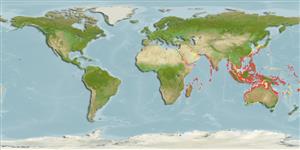Common names from other countries
Environment: milieu / climate zone / depth range / distribution range
Ecología
; rango de profundidad 1 - 37 m (Ref. 100968). Tropical
Distribución
Países | Áreas FAO | Ecosistemas | Ocurrencias, apariciones | Introducciones
Indo-West Pacific: from central East Africa, to Sri Lanka; from Andaman and Nicobar Islands to eastern Melanesia; north to Japan and south to Queensland and New Caledonia.
Length at first maturity / Tamaño / Peso / Age
Maturity: Lm ? range ? - ? cm Max length : 5.0 cm SHL macho / no sexado; (Ref. 349); common length : 4.0 cm SHL macho / no sexado; (Ref. 349)
Mainly collected for shellcraft, where the species is abundant (Ref. 349). Found on shallow waters, on weeds and sand (Ref. 799). Also occurs in shallow subtidal waters (Ref. 349).
Life cycle and mating behavior
Madurez | Reproducción | Puesta | Huevos | Fecundidad | Larva
Members of the order Neotaenioglossa are mostly gonochoric and broadcast spawners. Life cycle: Embryos develop into planktonic trocophore larvae and later into juvenile veligers before becoming fully grown adults.
Poutiers, J.M. 1998. (Ref. 349)
IUCN Red List Status (Ref. 130435)
CITES status (Ref. 108899)
Not Evaluated
Not Evaluated
Threat to humans
Harmless
Human uses
| FishSource |
Herramientas
Más información
Age/SizeCrecimientoLength-weightLength-lengthMorfologíaLarvaAbundancia
Fuentes de Internet
Estimates based on models
Preferred temperature
(Ref.
115969): 24.7 - 29.1, mean 28.2 (based on 1088 cells).
Vulnerability
Low vulnerability (10 of 100).
